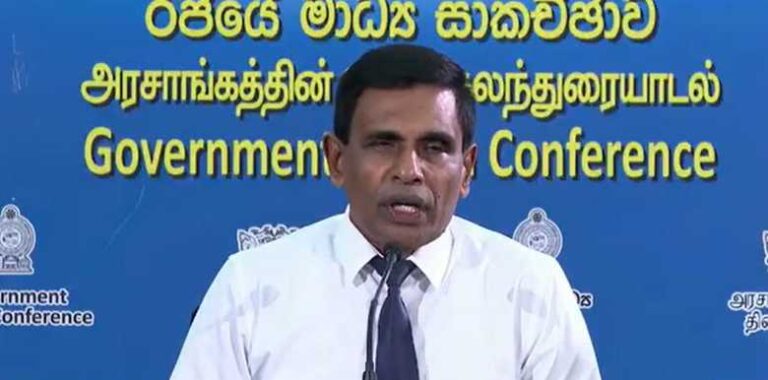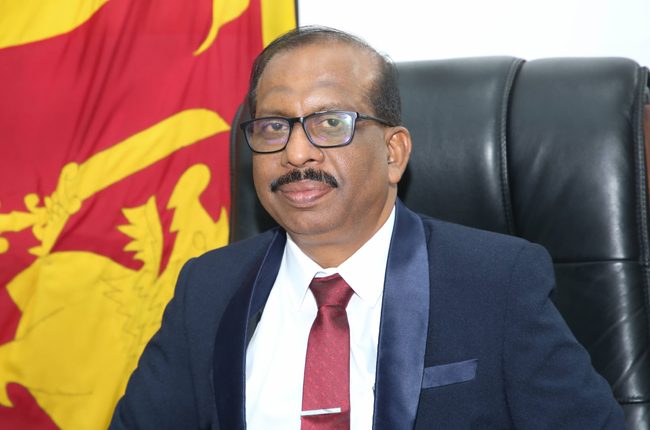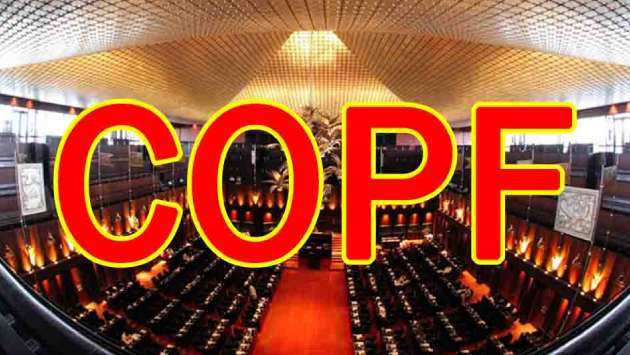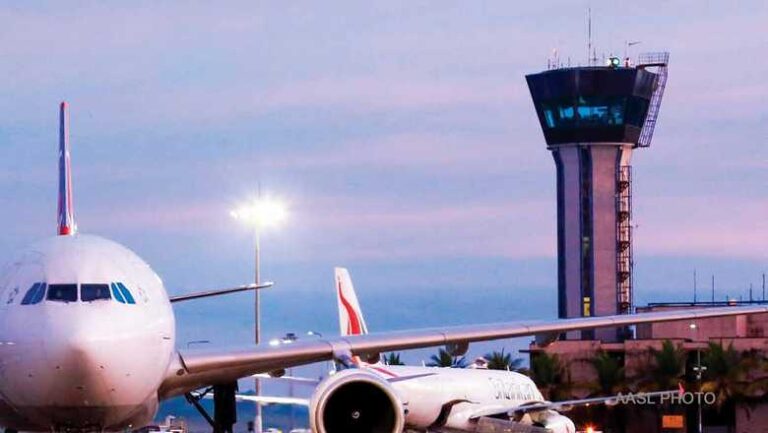October 26, Colombo (LNW): Public Security Minister Ananda Wijepala has directed the Inspector General of Police (IGP) to initiate a full investigation into a security threat reported by Member of Parliament Jagath Vithana.
The instruction follows concerns raised by the MP during a recent parliamentary session, where he alleged that he had received death threats.
Minister Wijepala stated that the IGP has been asked to examine the situation thoroughly and take all necessary measures to ensure the safety of the parliamentarian. He emphasised that any threat made against a public representative is a serious matter and that the authorities will act swiftly to identify those responsible.
The issue came to light during a parliamentary debate held last Friday, when MP Vithana publicly disclosed that he had been threatened with death. His statement prompted immediate concern among fellow legislators, several of whom called for enhanced protection for elected officials.
Minister Orders Police Inquiry into Death Threats Reported by MP Jagath Vithana
Govt Pledges Greater Investment in School and National Sports Development
October 26, Colombo (LNW): Minister of Youth Affairs and Sports Sunil Kumara Gamage announced in Parliament on Friday (24) that Sri Lanka Cricket (SLC) allocates close to Rs. 1.5 billion annually towards the advancement and promotion of school-level cricket across the island.
Responding to a question raised by National People’s Power (NPP) MP Upul Kithsiri, the Minister highlighted that these funds are channelled through the School Cricket Association to support a wide range of initiatives — from upgrading school cricket infrastructure and providing modern training equipment, to organising tournaments that nurture emerging talent at grassroots level.
Minister Gamage further revealed that discussions are under way with the School Cricket Association to enhance cricket facilities in several districts, ensuring that young players in rural communities have better access to quality playing fields and coaching opportunities.
He noted that work has already commenced on constructing an international-standard cricket stadium in Jaffna, while another is planned for Biyagama. Several additional locations have been earmarked for future stadium projects, as part of a broader strategy to bring professional-level cricket closer to local communities.
Beyond cricket, the Minister outlined a series of government initiatives aimed at strengthening Sri Lanka’s overall sporting ecosystem. These include ongoing programmes to uplift athletics under the Mission Olympics 2028 initiative and the Kreeda Shakthi scheme, both designed to identify and nurture young athletes with international potential. Plans are also being finalised to introduce special allowances for athletics coaches, recognising their critical role in shaping the next generation of sports talent.
Minister Gamage reaffirmed the government’s commitment to transforming school and community-level sports into sustainable development platforms, emphasising that investment in youth and sports will remain a national priority in the coming years.
Navy Rescues Foreign Crew After Merchant Vessel Suffers Technical Failure in Southern Seas
October 26, Colombo (LNW): A group of 14 sailors have been safely rescued after their merchant vessel encountered a serious technical malfunction while navigating waters south of Sri Lanka.
The Sri Lanka Navy launched an emergency operation to assist the distressed ship, deploying its offshore patrol vessel SLNS Sayura to carry out the rescue.
The stricken vessel, identified as MV Integrity Star, reportedly suffered a mechanical breakdown roughly 100 nautical miles off the southern coast.
The incident prompted an immediate response from the Navy following a distress alert, with rescue teams working swiftly under challenging sea conditions to ensure the crew’s safety.
According to Navy officials, all 14 crew members—comprising nationals of India, Türkiye, and Azerbaijan—were successfully transferred aboard the naval vessel and are currently en route to Hambantota Harbour for further medical checks and logistical assistance.
Ministry Warns Against Unauthorised WhatsApp Groups Claiming Links to Education Reforms
October 26, Colombo (LNW): The Ministry of Education and Higher Education has raised concerns over the emergence of several WhatsApp groups allegedly operating under the banner “Education Council to be Formed through the New Education Reforms.”
These groups, which claim to bring together teachers from different educational zones, have been identified as unofficial and misleading.
In a public statement, the Ministry clarified that it has no connection whatsoever to these networks and that neither the Ministry of Education, the Ministry of Higher Education, nor the Vocational Education Department has authorised or endorsed their activities.
Officials stressed that any initiatives or communications related to national education reforms will only be issued through verified and official government channels.
Authorities further indicated that preliminary inquiries suggest these online groups may have been established with the intention of creating confusion among educators and tarnishing the credibility of the government’s education reform programme.
The Ministry expressed concern that misinformation circulated through such platforms could erode public confidence and disrupt genuine reform efforts aimed at improving the education system.
Teachers and education professionals have been urged to exercise caution when engaging with unofficial online platforms and to verify the authenticity of any messages or circulars before sharing them further.
Thousands Affected as Heavy Rainfall Continues to Batter Several Districts
October 26, Colombo (LNW): Severe weather conditions that have persisted over the past few days have caused widespread disruption across much of the island, with 18 districts now reported to be affected.
The Disaster Management Centre (DMC) confirmed that nearly 30,000 people from over 7,000 families have suffered the consequences of the relentless downpours, which have triggered flooding, landslides, and property damage in multiple areas.
DMC Director Pradeep Kodippili noted that emergency teams have been mobilised to assist communities in the hardest-hit regions, providing temporary shelters, essential supplies, and relief assistance where necessary. Local authorities are said to be monitoring the situation closely as rainfall continues in several provinces.
Meanwhile, Dr Wasantha Senadeera, Senior Geologist at the National Building Research Organisation (NBRO), announced that the landslide warnings previously issued for 11 districts would remain in force due to persistent rain and increasingly unstable slopes. Residents living near hilly or elevated terrain have been urged to remain vigilant and to relocate to safer areas if early signs of ground movement are detected.
The Department of Irrigation has also cautioned that water levels in key rivers — including the Nilwala, Gin Ganga, Kalu Ganga, and Attanagalu Oya — are still alarmingly high following continuous rainfall. Officials have warned that further showers could cause these rivers to overflow, posing risks to nearby low-lying communities.
Authorities have called on the public to exercise caution, avoid unnecessary travel in flood-prone zones, and heed official updates as adverse weather conditions are expected to persist over the coming days.
Showers, thundershowers continue to persist: Fairly heavy falls exceeding 75 mm expected (Oct 26)
October 26, Colombo (LNW): The Department of Meteorology has forecast intermittent showers and thunderstorms across multiple regions of the island, with the Northern and North-Central Provinces, along with the Trincomalee and Batticaloa Districts, expected to experience particularly unsettled weather conditions.
According to the latest advisory, certain areas within these regions may record rainfall exceeding 75 millimetres, prompting officials to urge residents to remain alert for possible localised flooding and disruptions to daily activities.
In addition, the Western, Sabaragamuwa, Central, and North-Western Provinces are likely to see occasional showers throughout the day, though these are expected to be less intense than in the northern regions.
The department has also cautioned that strong gusts, ranging from 40 to 50 kilometres per hour, may affect the western slopes of the central hills and several coastal and inland provinces, including the Northern, North-Central, North-Western, Western, and Southern areas, as well as the Trincomalee District. These winds could cause minor structural damage and pose risks to outdoor activities and transport.
Authorities have advised the public to take necessary precautions against sudden bursts of strong winds and lightning strikes that could accompany thundershowers. Farmers, fishermen, and motorists, in particular, have been urged to exercise extra care over the coming days, as the weather may remain unstable.
Tariff Reforms Aim to Balance Protection and Fiscal Stability
By: Staff Writer
October 25, Colombo (LNW): Sri Lanka’s Committee on Public Finance (CoPF) has called for a comprehensive overhaul of the country’s tariff regime, even as it approved higher Special Commodity Levies (SCL) on key agricultural imports a move that underscores the continuing tension between protecting local farmers and maintaining fiscal discipline.
According to the Parliament Secretariat, the CoPF has approved an increase in the SCL on imported big onions and potatoes, effective 26 August 2025. The levy on big onions rose by Rs. 10 per kilogram from Rs. 40 to Rs. 50 while the levy on potatoes increased by Rs. 20, from Rs. 60 to Rs. 80. The revision aims to ensure fair farmgate prices during the 2025 Yala cultivation season and discourage cheap imports that undermine local producers.
Officials admitted that although the SCL was initially intended to be phased out, it continues to serve as a protective barrier for domestic agriculture. However, the CoPF cautioned that Sri Lanka’s tariff regime must evolve into a more transparent, predictable, and sustainable system, aligned with international trade norms.
The committee instructed the Ministry of Trade and the Ministry of Finance to harmonise existing legislation with the National Tariff Policy and fast-track the transition to a simplified four-band import duty structure. This reform, to be implemented between 2027 and 2030, envisions a gradual phase-out of para-tariffs such as SCL and CESS that have complicated the trade regime and created uncertainty for both importers and exporters. A comprehensive progress report is expected by March 2026.
Beyond tariff reform, the CoPF stressed the need to strengthen agricultural productivity to reduce long-term dependence on import restrictions. It recommended that the Department of Agriculture launch a national programme promoting high-yield cultivation kits for big onion farmers across all major growing regions within the next five years. The proposal includes establishing temperature-controlled storage facilities, implementing buy-back schemes, and introducing future contracts to minimise post-harvest losses and stabilise farmer income.
These measures, the committee argued, would help shift the focus from short-term tariff protection to long-term competitiveness, aligning with broader economic diversification goals.
In parallel, the CoPF also approved new regulatory measures under the Excise Ordinance to tighten enforcement and improve revenue collection from liquor manufacturers. Under the revised rules, manufacturers failing to pay duties within 30 days will face suspension of production, with sales and distribution halted after 90 days. The existing 3% monthly penalty on unpaid duties, the committee observed, has proven ineffective due to weak enforcement mechanisms.
Analysts note that these tariff and excise reforms represent a delicate balancing act between protecting domestic industries, maintaining revenue stability, and modernising Sri Lanka’s trade framework. If implemented effectively, the reforms could enhance investor confidence, boost agricultural efficiency, and reduce fiscal distortions crucial steps toward building a more sustainable and competitive post-crisis economy.
Sri Lanka Airports Brace for Tourist Air Traffic Surge
By: Staff Writer
October 25, Colombo (LNW): Sri Lanka’s aviation and airport sector is entering a critical phase of renewed activity as the winter tourism season approaches, with a notable surge in international arrivals and flight operations. Airport and Aviation Services (Sri Lanka) Ltd. (AASL) reports that both passenger volumes and air traffic are expected to rise sharply between November 2025 and February 2026 traditionally the island’s busiest travel period.
The Bandaranaike International Airport (BIA) in Katunayake and the Mattala Rajapaksa International Airport (MRIA) in Hambantota are preparing to handle expanded operations as several international airlines resume or introduce new routes to Sri Lanka. This influx is expected to support the country’s tourism recovery and boost foreign exchange inflows.
Among the new developments, Kuwait Airways will resume flights to Colombo on October 27 with four weekly services. Belarus’s national carrier Belavia Airlines will begin scheduled charter flights to MRIA from October 28, while Russia’s Red Wings Airlines is set to launch five weekly flights to Hambantota on the same day. Edelweiss, a subsidiary of SWISS International Air Lines, will also resume its winter operations to BIA, signaling confidence in Sri Lanka’s tourism rebound.
Polish carrier Enter Air will start regular charter flights between Warsaw and Colombo from October 30, operating every 10 days on Thursdays and Sundays until mid-April 2026. These additional connections are expected to strengthen Sri Lanka’s position as a winter sun destination for European travelers.
To cope with the anticipated passenger surge, AASL announced that 12 new check-in counters will be operational at BIA from November 1, 2025, as part of a short-term capacity expansion plan. The measure comes in response to growing requests from international airlines to increase flight frequencies and operate wide-body aircraft during the high season.
Further expansion of Sri Lanka’s aviation network is also on the horizon. Beijing Capital Airlines plans to commence twice-weekly flights from Beijing Daxing International Airport to Colombo in January 2026. Additionally, Jetstar part of Australia’s Qantas Group is exploring the possibility of launching scheduled services to Colombo next year, which could help tap into the growing South Asian Australian travel corridor.
Tourism performance indicators remain encouraging. By mid-October 2025, Sri Lanka had recorded over 1.8 million tourist arrivals, marking a strong post-pandemic recovery. The Government’s revised target of 2.6 million arrivals for 2025, however, requires attracting more than 800,000 visitors in the final quarter a challenge industry analysts describe as “ambitious but achievable,” contingent on global travel trends and the performance of the upcoming winter season.
Despite optimism, aviation officials stress the need for infrastructure upgrades, streamlined airport services, and policy stability to sustain growth. The expected air traffic surge underscores both the sector’s revival and the urgency to address operational bottlenecks, ensuring Sri Lanka remains competitive as a regional aviation and tourism hub.
Micro-finance Crisis Deepens: Vulnerable Borrowers Trapped in Debt
By: Staff Writer
October 25, Colombo (LNW): The Sri Lankan government has kicked off a data‐collection drive aimed at unraveling the troubling dynamics of the country’s microfinance sector an industry whose rapid expansion has saddled thousands of vulnerable borrowers with unmanageable debt and, tragically, driven some to suicide. The directive, issued by the Sub-Committee on Rural Development, Social Security and Community Empowerment, targets borrowers in four pilot Divisional Secretariat Divisions: Hatton (Nuwara Eliya), South Koralaipattu (Batticaloa), Welikanda (Polonnaruwa) and Wellawatte (Colombo), where officials will compile systematic data on individuals unable to repay microfinance loans.
The timing of the initiative signals growing alarm in Colombo about the shape of lending practices across the microfinance field. According to recent research, non-government microfinance institutions (MFIs) have succeeded in expanding outreach but at the cost of mounting borrower indebtedness: one study found that up to 70 per cent of rural borrowers were trapped in debt cycles, with average burdens around Rs 150,000.
Unregulated interest rates, rigid repayment schedules and aggressive collections have become common complaints among borrowers.
Despite the proliferation of micro-loans, the legal and regulatory environment remains weak. The long-awaited Microfinance Act is yet to be passed in Parliament, and the Central Bank of Sri Lanka (CBSL) register currently lists only four institutions, according to Governor Nandalal Weerasinghe. The discrepancy between official numbers and the many thousands of informal or semi-formal lenders operating on the ground has left swathes of borrowers outside formal oversight.
The pilot data collection aims not only to quantify the scale of default and distress, but also to design relief measures and rehabilitation programmes. Representatives of the 34 microfinance institutions registered with the Lanka Microfinance Practitioners’ Association (LMfPA) have been summoned for consultations. The Sub-Committee is discussing potential interventions for borrowers facing multiple loans, spiralling repayments and coercive recovery tactics.
From sectoral analysis, it’s clear that many micro-finance borrowers—especially women in rural or post-conflict areasare borrowing not for investment but to cover household expenses, pay prior loans or cope with income shocks.
This has produced a pernicious cycle: taking new loans to service old ones, mounting interest, and deteriorating conditions.
Critics argue that the micro-finance model in Sri Lanka has tilted toward “loan‐shark”-style practices, unchecked by robust regulation. Numerous reports link aggressive collection, multiple overlapping loans and even suicides among borrowers who feel trapped and powerless.
For the CBSL and the government, the task ahead is substantial. Crafting and passing the Microfinance Act is only the beginning. Regulatory capacity must be strengthened, interest rate caps considered, borrower protection mechanisms implemented and enforcement scaled up to bring informal lenders into oversight. Transparent data collection will help—but equally important is enforcement of fair recovery practices, financial literacy training and rehabilitation pathways for indebted households.
Without such interventions, the very tool meant for financial inclusion may become a source of deep social and economic damage undermining livelihoods, creating distress and placing the risk back on depositors, taxpayers and the broader economy. The pilot data initiative offers hope, but it must be followed by decisive regulatory action and accountability across the micro-finance sector.
Sri Lanka’s Construction Code Push Meets Industry Revival Surge
By: Staff Writer
October 25, Colombo (LNW): The Sri Lankan government is fast-tracking the development of a legally enforceable national building code, a move seen as overdue yet crucial amid a concurrent rapid rebound in the country’s construction sector. National Building Research Organization (NBRO) officials, aided by World Bank technical support, have prepared the framework for what Cabinet spokesman Nalinda Jayatissa described as comprehensive standards addressing building structural integrity, fire and electrical safety, plumbing, energy efficiency and disaster resilience.
With the building industry projected to grow by about 7.9% in real terms in 2025, driven by both public and private investment, the timing of the code rollout is critical.
The official construction PMI climbed to 52.9 in January 2025 from 51.4 in December 2024, indicating broad‐based expansion in activity, new orders, and input purchasing.
Industry insiders note that the pipeline of new residential, commercial and infrastructure projects is gaining momentum though consistent data on active building counts remain sparse.
Why now? Sri Lanka has long operated without a unified national code, which has left structural safety, build quality and regulatory oversight patchy. “In the absence of a national building code currently in force, Sri Lanka has faced serious issues relating to structural safety, quality, and regulation of the construction industry,” Jayatissa acknowledged. The IMF had previously designated developing climate-resilient building codes as a priority reform area for Sri Lanka.
The upcoming code will set legally enforceable standards across the lifecycle of buildings—from design to maintenance and alteration. This represents a major step beyond prior guidelines. Yet, the construction sector’s accelerated growth—buoyed by renewed investor interest, mass housing and infrastructure programmes, and improving economic sentiment—heightens the urgency for robust frameworks.
The expansion is not without risk. Rapid growth in construction often outpaces regulatory capacity and enforcement mechanisms. Supply‐chain strains, rising materials and labour costs, and a surge of small‐scale developments can amplify vulnerabilities unless controls keep pace. The January 2025 bulletin from the Construction Industry Development Authority (CIDA) also flagged monthly volatility in material price indices and labour cost swings.
By embedding standards for fire safety, electrical systems, plumbing, energy efficiency and disaster resilience, the new code aims to mitigate risks associated with landslides, flooding and earthquakes hazards increasingly relevant in Sri Lanka’s changing climate. The government’s recent approval of the NBRO project proposal marks the official launch of the governance architecture for the codes.
Still, implementation will be the real test. Moving from blueprint to enforcement requires clarity on institutional roles, funding, training of inspectors, and mechanisms for compliance and penalties. The code’s success will depend on how swiftly it can be rolled out across both high-end and informal construction, and how effectively it aligns with the industry’s growth trajectory currently.
As Sri Lanka’s construction sector regains momentum, the national building code stands as a necessary partner to that revival ensuring growth is not just fast, but safe, sustainable and resilient.










